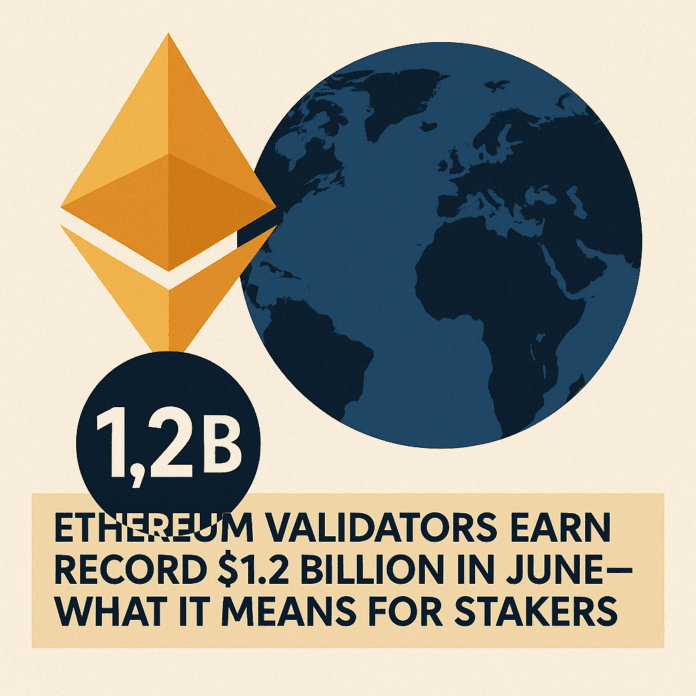Ethereum, largely seen as the second-largest cryptocurrency in the world behind originator Bitcoin, saw a huge milestone for its validators last month. During the month of June, validators earned $1.2 billion in rewards as Ethereum hit a new plateau. It is big news for stakers of ETH, the requirement to become a validator on the Ethereum blockchain.
This is certainly great news for validators, but what kind of impact does this have on stakers? A closer look reveals that these developments could present rewarding challenges for those looking to stake their ETH tokens.
What Does This Mean for Ethereum Stakers?
On the surface, this is a tremendous bit of news for stakers of Ethereum. Rewards have never been higher, and the cryptocurrency market is believed to be heading into a bearish upswing, according to market experts.
For stakers, this means two things. For one, the chance to earn more rewards than ever before is at hand. As Ethereum continues to grow amid technical improvements and rollouts, there is a greater need for validators than ever before. These changes aim to improve transaction processing speed, which would increase the demand for handling those transactions.
While that is a good thing for stakers, there will also likely be far more competition among validators. More stakers means fewer opportunities to consistently earn rewards on the blockchain. For those who have consistently earned staking rewards, those consistent opportunities may not be there.
For now, things lean on the side of potential, but challenges remain afoot. It is definitely good news for the blockchain as a whole, since transactions will now be done faster and at a lower cost than before.
Staking Landscape Expands
It is estimated that the total number of validators on the Ethereum blockchain stands at 1.088 million. Moreover, staking activity, as a whole, continues to move on an upward trajectory. This is huge news for the Ethereum ecosystem.
Major entities like Lido, Binance, Coinbase, and others continue to hold large stakes, though unidentified entities currently account for nearly 20% of the total Ethereum currently staked. These patterns show that there is growing adoption and diversification of stakers around the globe.
How Validators Impact Ethereum
Before you can learn how to stake Ethereum, it helps to know what kind of role the validators play on the Ethereum blockchain. Validators are integral to the overall functionality and health of the Ethereum system, which ultimately maintains the integrity of the network. Here’s how validators make an impact.
Block Proposal
One of the most integral functions of validators on the Ethereum network is to propose new transaction blocks to be included on the blockchain. A validator is selected at random once every 12 seconds to propose a new block. These validators compile the transactions that they have validated into a block, proposing its inclusion into the blockchain.
Proposers are randomly selected to ensure both fairness and security. That in-protocol randomness comes from the RANDAO mechanism, which is essentially a random number generator. When a validator is chosen, a random contribution is mixed with the current RANDAO value, and ultimately a new number is generated.
After the validator has proposed a block, it doesn’t immediately get added to the blockchain. First, it has to be not only validated but also attested to by other validators. This ensures the integrity of the block while also enabling the proposer to earn their reward while also receiving the potential to earn much larger rewards.
Sync Committees
Another essential part of the proof-of-stake framework is sync committees. Once every 256 epochs—roughly 27.3 hours—a group of 512 validators is chosen to authenticate snapshots of the blockchain. This means offline nodes or new nodes are able to update and sync without having to verify each underlying transaction.
It should be noted that it is a rare occurrence for validators to be selected as part of a sync committee, averaging out to one validator every 37 months. During these terms, rewards are much higher as validators earn rewards for every slot where their responsibilities have been fulfilled. It can be a bit confusing and stagnant but very rewarding.
Factors That Influence Staking Rewards
How much a validator can earn in rewards does tend to fluctuate because of a number of factors. Though the reward mechanism is quite transparent—not to mention non-reliant on counterparties and independently verifiable—rewards can vary. These are the biggest factors involved.
Validator Performance and Uptime
Rewards tend to be most proportional to the uptime of the validator. This basically means that the validator is online and performing its duties in order to earn maximum rewards. Validators that go offline or can’t perform their duties are subject to small penalties.
Past that, there are other minor offences like breaking protocol rules. Validators that do this could be subject to slashing, which is a severe penalty and should definitely be avoided at all costs.
Active Validators
In order to ensure that the network gets the right amount of crypto-economic security, its protocol will adjust ETH issuance depending on how many validators are active at any one time. Rewards tend to increase when the total number of validators decreases, and vice versa.
Block Proposals
Another factor is that the network introduces randomness when selecting its validators for block proposals. This is to help ensure that the selection of validators is fair while also upholding Ethereum security standards.
Being selected as a block proposer equates to much higher priority fees that come from all transactions executed on the block. MEV that is captured during proposals can also add to the validators’ earnings. Think of it as an extra layer of rewards that validators can earn as part of the process. These factors can all vary and may not be the same.
Coinbase, the Largest Ethereum Node Operator
Coinbase’s stake in Ethereum makes it the single largest node operator on the blockchain. Coinbase has more than 11% of the staked ETH supply through its own validators. With an average uptime of 99.75%, it has been outperforming its own standards without requiring any compromise of its security standards.
Coinbase noted that its validators are distributed throughout several regions in order to keep a distributed and decentralised Ethereum blockchain with validators in Singapore, Germany, Ireland, Japan, and Hong Kong.
ETFs Signaling Long-Term Confidence
In other good news for Ethereum, exchange-traded funds (ETFs) recently recorded a 15-day streak of inflows. This is a significant development, as it shows that whales are preparing for a major price movement as ETH continues to outshine Bitcoin when it comes to ETF inflows.
Participants in the market feel confident that ETH could see a major uptick, especially as there is further institutional support for crypto. The token recently hit a record high of more than $3,000, and some projections have it hitting the $6,000 mark before 2025 comes to an end.

